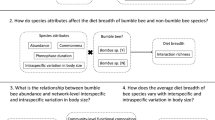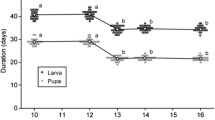Abstract
Plant–herbivore interactions are complex and affect herbivore fitness components and life history traits in many different ways. In this paper, we present results from an experiment studying the effects of leaf quality on pupal survival and duration of pupation (as measured by time-to-emergence) in the winter moth. Because only surviving pupae are at risk of emerging, analysis of time-to-emergence should exclude the dead pupae. However, due to right censoring, the survival status could not be determined for each individual. This failure to determine the group of moths at risk of emerging a priori motivated the development of a joint model of both survival probability and time-to-emergence. We formulate the model in a Bayesian framework and apply Monte Carlo Markov Chain (MCMC) to obtain posterior distributions. Time-to-emergence is modeled by a Cox Proportional Hazards (CPH) model where only the surviving pupae are at risk of emergence. Probability of pupal survival was modeled by a Generalized Linear Mixed Model (GLMM). The censored individuals were included in the analysis as a missing value in the GLMM. The GLMM then generated prior distributions of survival probabilties—and thus of the probability of being at risk of emergence—for these 19 individuals, conditional on the model parameters. The CPH model was formulated as a count process and the binary frailty was incorporated as a zero-inflated Poisson model. Zeros in this model represent the non-survivors. Leaf quality did not appear to influence time-to-emergence. Pupal survival was affected in a complex and unexpected way showing opposite effects in males and females. We also explored the robustness of our model against increased levels of censoring. While the degree of censoring was low in our study (< 1%), we artificially increased it to 67%. Although further study is required to study the generality of these results in a theoretical framework, our explorations suggest that the newly proposed technique may be widely applicable in a variety of situations where the identification of the at risk population cannot be done in a straightforward way.
Similar content being viewed by others
References
O Aalen (1976) ArticleTitleNonparametric inference in connection with multiple decrement models Scand J Stat Theory Appl. 3 15–27
ER Brown JG Ibrahim (2003) ArticleTitleBayesian approaches to joint cure-rate and longitudinal models with applications to cancer vaccine trials Biometrics 59 686–693 Occurrence Handle14601770 Occurrence Handle10.1111/1541-0420.00079
BP Carlin TA Louis (2000) Bayes and empirical bayes methods for data analysis Chapman and Hall London
P Congdon (2001) Bayesian statistical modelling Wiley Chichester
MK Cowles BP Carlin (1996) ArticleTitleMarkov Chain Monte Carlo convergence diagnostics: a comparative review J Am Stat Assoc 91 883–904 Occurrence Handle10.2307/2291683
MJ Crawley M Akhteruzzaman (1988) ArticleTitleIndividual variation in the phenology of oak trees and its consequences for herbivorous insects Funct Ecol 2 409–415
P Feeny (1970) ArticleTitleSeasonal changes in oak leaf tannins and nutrients as a cause of spring feeding by winter moth caterpillars Ecology 51 565–581 Occurrence Handle10.2307/1934037
A Gelman (2005) ArticleTitlePrior distributions for variance components in hierarchical models Bayesian Stat 1 1–19 Occurrence Handle10.1214/009053604000001048
A Gelman JB Carlin HS Stern DB Rubin (1995) Bayesian data analysis Chapman and Hall London
M Ghahramani CB Dean JJ Spinelli (2001) ArticleTitleSimultaneous modeling of operative mortality and long-term survival after coronary artery bypass surgery Stat Med 20 1931–1945 Occurrence Handle11427950 Occurrence Handle1:STN:280:DC%2BD3Mzms12gsA%3D%3D Occurrence Handle10.1002/sim.822
WR Gilks S Richardson DJ Spiegelhalter (1996) Markov Chain Monte Carlo in Practice Chapman and Hall London
GR Gradwell (1974) The effects of defoliators on tree growth MG Morris FH Perring (Eds) The British Oak. Its history and life history F.W. Classey Flaringdon 182–193
R Henderson P Oman (1999) ArticleTitleEffect of frailty on marginal regression estimates in survival analysis J Roy Stat Soc Ser B 61 367–379 Occurrence Handle10.1111/1467-9868.00182
J Kalbfleish (1978) ArticleTitleNon-parametric bayesian analysis of survival time data J Roy Stat Soc Ser B 40 214–221
DJ Spiegelhalter NG Best BP Carlin A Linden ParticleVan Der (2002) ArticleTitleBayesian measures of complexity and fit J Roy Stat Soc Ser B 64 583–639 Occurrence Handle10.1111/1467-9868.00353
Van Dongen S (1997). The population structure of the winter moth Operophtera brumata in relation to local adaptation and habitat fragmentation. PhD. Dissertation, University Of Antwerp.
S Dongen ParticleVan T Backeljau E Matthysen AA Dhondt (1997) ArticleTitleSynchronization of hatching date with budburst of individual host trees (Quercus robur) in the winter moth (Operophtera brumata) and its fitness consequences J Anim Ecol 66 113–121
Author information
Authors and Affiliations
Corresponding author
Additional information
Received: January 2005 / Revised: June 2005
Rights and permissions
About this article
Cite this article
Van Dongen, S. Bayesian Joint Estimation of Binary Outcome and Time-to-event Data: Effects of Leaf Quality on Pupal Survival and Time-to-Emergence in the Winter Moth. Environ Ecol Stat 13, 213–228 (2006). https://doi.org/10.1007/s10651-005-0005-1
Issue Date:
DOI: https://doi.org/10.1007/s10651-005-0005-1




